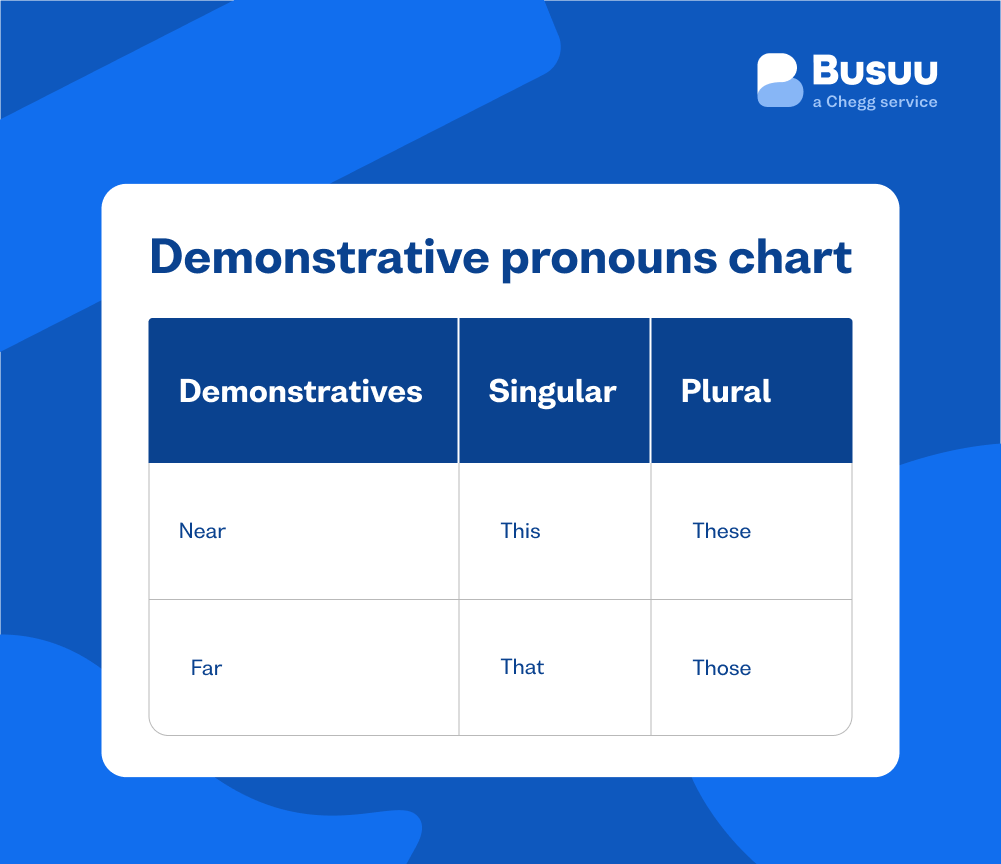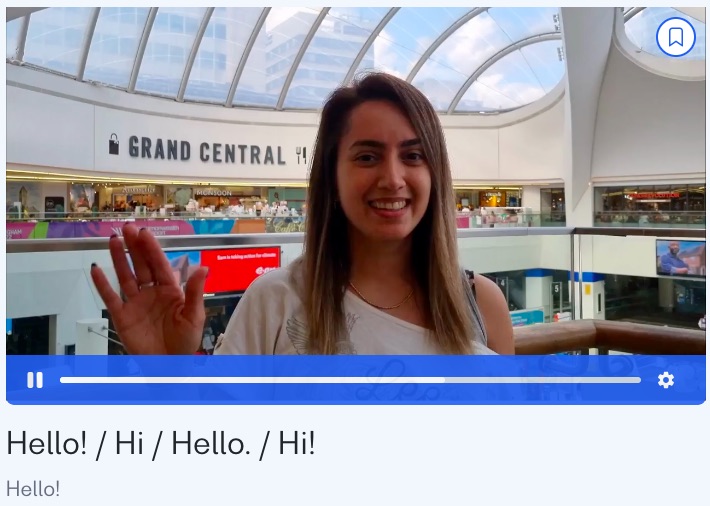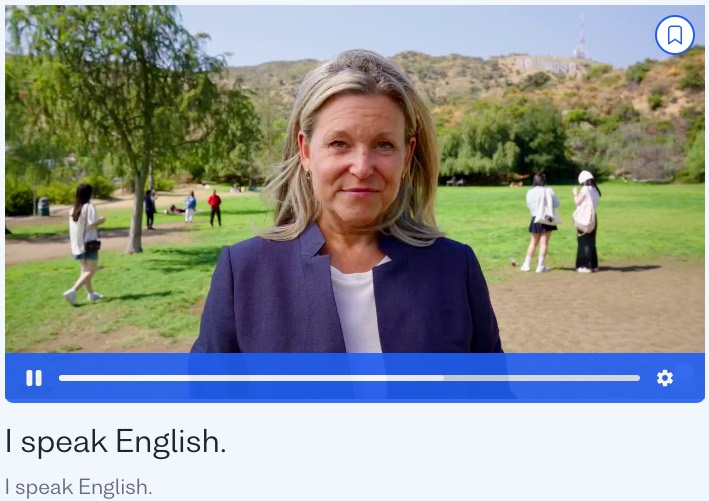Pronouns in English and How to Use Them in Daily Conversation
Learn when and how to use pronouns.
I want to learn...
In the flow of conversation or writing, it’s common to leave a noun out after you’ve introduced it in a previous sentence (or during the beginning of the same sentence). Instead, you’ll find a pronoun in its place. In this article, we’ll focus on how to use them correctly.
What is a pronoun?
Pronouns have two main uses: they can make your sentences clearer (by identifying who or what you’re referring to and in what context), or, they can be used to improve the speed and flow of writing or conversation. They’re actually a type of noun, but they’re different to regular nouns in that you introduce them at some point after you’ve introduced the noun of an object or person.
It’s important to remember, though, that if you bring in a pronoun in a sentence, it could be confusing if you reintroduce the noun somewhere in the same sentence.
There are seven different types of pronouns in English. These are:
- Personal
- Demonstrative
- Interrogative
- Relative
- Indefinite
- Reflexive
- Intensive
We’ll look at each of these later, but first let’s look at nouns as antecedents.
Antecedents
The noun that comes before a pronoun in a sentence is known as an antecedent. You’ll need to have an antecedent somewhere in a sentence or the same paragraph in order to use a pronoun (in most cases). If this is not the case, it isn’t that clear what or who you are referring to. In the example below, the antecedent is italicized, while the pronoun is underlined (so you can see how they relate to each other):
“Alex looked down and saw he was on the highest floor in the building.”
Let’s imagine Alex is a man in this sentence: you usually use the personal pronoun “he” if you want to use it in place of the antecedent (Alex’s name). If you didn’t have the antecedent in the sentence here (Alex), then it wouldn’t be clear who “he” was.
There are some exceptions to this rule, though, which are usually when a reader or listener knows who you’re referring to already. When you’re using personal pronouns like “we”, or “I”, they are likely to already know that you’re referring to them as part of a group, or yourself.
Personal pronouns
Firstly, we’ll look at personal pronouns before moving onto the other six types of pronouns. Here’s an example for you to consider:
“Billy is in the library. He’s searching the non-fiction section, because Billy needs books for his degree.”
As you can see, it’s not clear whether the sentence is still referring to the same Billy – after all, Billy might have a friend with the same name. And even if it were clear to the reader, it makes the sentence sound unnatural. Instead, you can make the sentence clearer by saying:
“Billy is in the library. He’s searching the non-fiction section, because he needs books for his degree.”
In our above examples, we’ve used subject pronouns, which usually involve referring to someone by their gender. Subject pronouns include: I, / we (first person) , you (second person) and he / she / they (third person)
Tip: You don’t need to introduce a person or object’s noun every time you start a new sentence. Pronouns help to create some variety to your speech or writing if you add one in after you’ve introduced a noun.
If you’re feeling like this is a lot to get your head around, we’ve got some tips for learning English easily.
_Tip: In English, objects are rarely gendered. You might hear someone describing a boat as “she”, but this is quite old-fashioned. It’s more likely to come up in an old book rather than a conversation. Nevertheless, It can also be used quite colloquially in modern speech, for example when a person feels affection towards a vehicle they own - a car, motorbike etc.
What are demonstrative pronouns?
Demonstrative pronouns are used to describe objects, or can be used to replace objects in a sentence. These pronouns are “this”, “those”, “that”, and “these”. You can only use them in certain contexts however:
- When you’re pointing towards an object (either near or far)
- When you’re referring to something you’ve just mentioned (this can also be an abstract concept or idea)
Demonstrative pronouns when you’re pointing towards something
Whether the object is near or far from you will affect the kind of demonstrative pronoun you need to use. If you need to pick out an object that’s physically close to you, then you need to use demonstrative pronouns like “this”, or “these”. Imagine you have three balls in front of you, but only want to discuss one. You point to one of the balls and say:
“This is the ball I mean / This is the ball I'm referring to"
You can also use “this” or “these” to talk about an idea that you’ve just mentioned, and want to discuss it further.
If you need to talk about something that’s far away from you, you’ll need to use the demonstrative pronouns “that” or “those”. Let’s look at how to use these types of demonstrative pronouns in a sentence.
If you want to point out some pretty flowers you've spotted, you might say:
"Those over there are very pretty."
Use “that” or “those” for ideas that you haven’t immediately discussed, and want to return to.
Below is a chart that can help you remember the different forms for singular and plural demonstrative pronouns

Demonstrative pronouns chart
| Singular | Plural | |
|---|---|---|
| Near | This | These |
| Far | That | Those |
Now that we’ve covered demonstrative pronouns, let’s move on to using interrogative ones.
What are interrogative pronouns?
Interrogative pronouns are used when you’re asking a question. In English, these are “what”, “who”, “whose”, and “which”, and they’re all used in specific contexts. Usually, you’ll find them at the beginning of a question. For example:
"Which do you like the best?"
Now, let’s look at the contexts you’ll be using these interrogative pronouns in:
- Use “what” when you’re asking for information about something specific, like someone’s name. You can ask, “what is your name?”
- Use “who” when you’re asking questions about people. For example, “who did this?”
- Use “whose” when you’re trying to find out information on who owns something. You can say “whose are these?”
- Use “which” when you’re trying to identify an object or person in a group. An example is “which did you like the best?”
When to use what vs which
In English, “what” and “which” are used to ask questions about objects. However, you tend to use them in different contexts. You use “what” when there’s a wide range of answers to your question. On the other hand, you use “which” if there is a limited range of answers to choose from, for example from a list or a menu you’re reading.
Interrogative pronouns as relative pronouns
Interestingly, interrogative pronouns often double up as relative pronouns, which we’ll now look at below.
What are relative pronouns?
You use relative pronouns when you need to introduce more information about people or objects in a sentence. They are “who”, “which”, “that”, “whose”, “where”, and “when”. Relative pronouns introduce what are known as relative clauses in a sentence. Let’s quickly look at an example:
“Frida Kahlo was a painter who is famous for her portraits.”
The relative clause here is “is famous for her portraits”, thanks to the relative pronoun “who” in the sentence. You use the relative pronoun “who” if you want to be able to describe a person. However, you use “which” for objects. For example:
“This is the house I grew up in, which had a beautiful garden.”
The relative pronoun “that” is used for both people and objects. Here are two examples so you can see how they’re used in the same way for both:
“The shoes that I bought don’t fit properly.” “She was the girl that I saw yesterday.”
You use “whose” if you want to discuss an object that someone owns. Here’s how “whose” is used in a sentence:
“The man, whose dog had run away, looked very worried.”
Next, let’s tackle indefinite pronouns.
What are indefinite pronouns?
Indefinite pronouns include: “anybody/anyone”, “anything”, “everybody/everyone”, “everything”, “none”, and “somebody / someone”. They’re used to refer to any object or person where their quantity is not specific, and so is vague or unknown. For example:
“Everybody had a great time.”
Indefinite pronouns like “everybody / everyone”, “anybody / anyone”, and “somebody / someone” refer to indefinite quantities of people. Those like “anything”, “everything”, or “nothing” refer to indefinite quantities of things. You can also use indefinite pronouns like “one”, “none’, “another”, “all”, “some”, “many”, and “several” to refer to both objects and people.
"Many", "some", "several", and "all" are followed by a plural verb. You use a singular verb after an indefinite pronoun, such as in:
“Everybody had a great time.”
The singular verb here is “had”.
Using reflexive pronouns
You use reflexive pronouns when the subject and the object are the same. They end in "self" for singular nouns and "selves" for plural nouns. You’ll find this in sentences where a person is referring back to themselves. Let’s explore some examples:
“I found myself in a beautiful house.” “She hurt herself in a skiing accident.” “He is looking after himself.” “They looked out for themselves.” “We need to do it ourselves.”
You usually use reflexive pronouns in contexts where it’s important to emphasize that someone is doing something and nobody else is. For example:
“I made dinner myself this time.”
Finally, let’s look at intensive pronouns.
Using intensive pronouns
Intensive pronouns are actually a form of reflexive pronoun. However, you use them in this case in order to emphasize the subject in the sentence more. You might use a reflexive pronoun in a sentence if you want to express surprise. For example:
“The president himself appeared to give a speech.” “The girl drew the picture all by herself.”
So that just about wraps up the different kinds of pronouns and their uses!
Wrapping up
Pronouns can help make your sentences sound more natural and can replace all sorts of nouns. We hope that this quick guide helps you to become more familiar with the different rules for each, and which context to use them in.
Want to practice English grammar your way?
Busuu lets you choose your learning direction, no matter what your reason is for picking up a language. Get access to free online courses and learning resources and start learning today!

